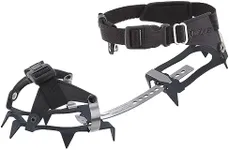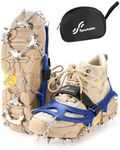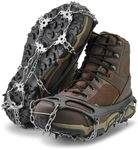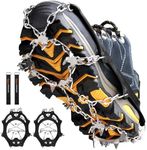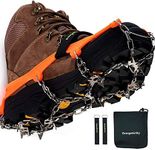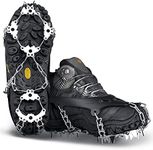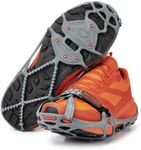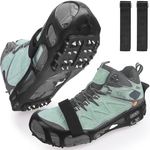Buying Guide for the Best Ice Cleats For Walking
When choosing ice cleats for walking, it's important to consider several key specifications to ensure you get the best fit for your needs. Ice cleats are designed to provide traction on icy and snowy surfaces, preventing slips and falls. The right pair will depend on factors such as the type of terrain you'll be walking on, the level of traction you need, and the ease of use. Here are some key specifications to consider when selecting ice cleats for walking.TractionTraction refers to the grip that the ice cleats provide on icy or snowy surfaces. This is crucial for preventing slips and falls. Ice cleats typically have spikes or studs made of metal or hard plastic. For light use on sidewalks and driveways, cleats with smaller, fewer spikes may suffice. For more rugged terrain or frequent use, look for cleats with larger, more numerous spikes for better grip. Consider your typical walking environment to determine the level of traction you need.
MaterialThe material of the ice cleats affects their durability and performance. Common materials include rubber, silicone, and metal. Rubber and silicone are flexible and easy to put on and take off, making them suitable for casual use. Metal components, such as spikes or chains, provide superior traction and durability for more demanding conditions. Choose a material that matches your usage frequency and the severity of the icy conditions you encounter.
Fit and SizeFit and size are important to ensure the ice cleats stay securely on your shoes. Ice cleats come in various sizes, often corresponding to shoe sizes. Some models are adjustable, allowing for a more customized fit. A proper fit ensures that the cleats won't slip off while walking and that they provide consistent traction. Measure your shoe size and check the manufacturer's sizing guide to select the right size. If you plan to wear bulky winter boots, consider this when choosing the size.
Ease of UseEase of use refers to how simple it is to put on and take off the ice cleats. This is important for convenience, especially if you need to frequently switch between indoor and outdoor environments. Some ice cleats have a slip-on design, while others use straps or buckles for a more secure fit. Consider how often you'll need to remove and reattach the cleats and choose a design that fits your lifestyle. If you have limited mobility or dexterity, look for cleats that are easy to handle.
WeightThe weight of the ice cleats can affect your comfort and mobility. Lighter cleats are generally more comfortable for extended wear and less tiring to walk in. However, heavier cleats may offer better durability and traction. If you plan to wear the cleats for long periods or over long distances, opt for a lighter pair. For short-term use or in very icy conditions, the added weight of more robust cleats may be beneficial.
DurabilityDurability refers to how well the ice cleats hold up over time and with repeated use. This is influenced by the quality of materials and construction. Durable ice cleats are essential if you plan to use them frequently or in harsh conditions. Look for cleats with reinforced components and high-quality materials. Read reviews and check for any warranties or guarantees offered by the manufacturer to ensure you're getting a reliable product.

